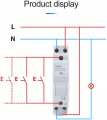MisterBill2
- Joined Jan 23, 2018
- 19,588
What makes this project challenging is that the control is an alternate action single input relay. If there were separate controls for on and off the task would be quite a bit simpler.
Is there a single point where monitoring the daylight intensity will be done? So that a single sensor will be satisfactory? And how much complexity is acceptable? It is easy to accomplish with a very small PLC: Two outputs, (Lights feed control and sun sensor power), and three inputs, (lights power on, sunlight detected, and push-button pressed.)
This could be a low-priced unit from Automation Direct, or some other supplier .
The lights power on input is required because there is no absolute control as to if the next pulse switches the light on or off.
Is there a single point where monitoring the daylight intensity will be done? So that a single sensor will be satisfactory? And how much complexity is acceptable? It is easy to accomplish with a very small PLC: Two outputs, (Lights feed control and sun sensor power), and three inputs, (lights power on, sunlight detected, and push-button pressed.)
This could be a low-priced unit from Automation Direct, or some other supplier .
The lights power on input is required because there is no absolute control as to if the next pulse switches the light on or off.







